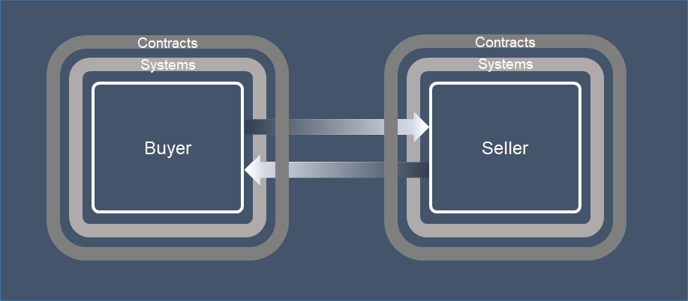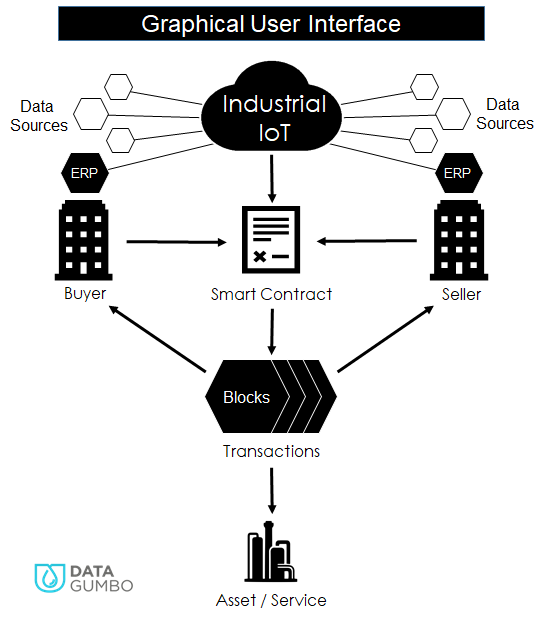An overview of Data Gumbo’s networking platform, GumboNet, and how smart contracts drive efficiency for the value chains of the industry by establishing trust and automating transactions between companies.
Problem Statement
The Oil & Gas industry is a well-documented laggard compared to other industries when it comes to leveraging technology to drive business process improvement. One underlying cause of this lagging performance is rooted in the way the industry develops, operates, and maintains the complex physical assets required to deliver value. These processes have essentially remained unchanged in the face of technology advances adopted by other industries to transform the way companies across the supply chain work together.
Developing, operating, and maintaining complex physical assets such as buildings, infrastructure, utilities, process, and manufacturing plants requires many parties to come together to apply the skills and resources necessary to conceive, design, procure, assemble, construct, commission, operate, maintain, and retire assets. These parties are often brought together for one-time events such as a project or low-bid service contracts and therein lies the fundamental problem – a lack of trust cemented by disparate cultures, disconnected technology, and legal constructs that place entrenched barriers between parties that make efficiency impossible.
This problem is illustrated in the diagram below where the arrows indicate the flow of data and information between the parties that is required for the transaction to occur. The buyer and seller have different systems that do not easily “talk” to each other and the contract between them contains provisions to shield against risks and create adversarial conditions. Together these factors significantly degrade both the quality and timing of the flow of information between them.

Contract Automation Solution
The oil & gas industry remains stuck in a “paper-based” operating model that relies on the creation and movement of documents (paper or digital) through antiquated review and approval processes. Modern Enterprise Resource Planning (ERP), Computerized Maintenance Management Systems (CMMS), Project Management Information Systems (PMIS) and embedded workflow engines do provide some moderate efficiencies, but these technologies simply perpetuate the paper-based processes and thinking that are codified in the industry’s contracts and purchase orders. To bring about the digital transformation of our industry, from “paper-based” to “digital” ways of working, we must start with the legal instrument that binds companies together – the contract. By developing and deploying smart contracts across the Oil & Gas asset life cycle we can facilitate the transformation from paper to digital thinking and bridge the Trust Gap that exists between companies.
GumboNet Networking Platform
The shift to a smart contract execution model requires the deployment of four technologies that form a business-to-business platform where companies connect through smart contracts (shown below).

-
The anchor of the platform is the Smart Contract that defines the commercial relationship between the parties.
-
The smart contract is fed from an Industrial Internet of Things (IoT) data platform that captures the specific data from a wide array of sources (ERP and Edge ) that is required to execute the terms defined by the smart contract.
-
The transaction along with the supporting data/information and any contemporaneous documentation required to substantiate the transaction is then recorded to a data “block” in a Distributed Ledger or Blockchain that replicates the transaction for review and approval (consensus) by the contractual parties.
-
Transactions are reviewed through a Graphical User Interface that also includes status, performance metrics, and other dashboard information.
Smart Contract
The smart contract is a software program that automates the execution of transactions required to fulfill the terms and conditions of a contract. The smart contract uses inputs of data and information that verify that the conditions have been met to execute the transaction – the creation of value and the corresponding compensation for the value received.
Industrial IoT Data Platform
The IoT data platform is required to capture specific data and information relating to contract performance from a wide array of sources and the data must be validated before it can be utilized to execute the terms of the smart contract. The validation is performed by associating the incoming data with a defined schema so that the data can be effectively classified before it is used. The schema is a data model based on the digital twin of the asset and data tags are created and associated to components of the digital twin. The tags represent the incoming performance data required to validate the conditions defined in the smart contract.
Distributed Ledger
The distributed ledger is where the transactions executed by the smart contracts are recorded in an immutable data block that is replicated to each contractual party for review and consensus approval. Companies are established through a node on the blockchain and are “connected” to other companies through smart contracts. All the source data and calculations required to execute the transaction are recorded along with any contemporaneous documentation (certificates, inspection reports, pictures, drawings, specifications, etc.) necessary or wanted to substantiate the execution of the transaction. The data block is linked to the previous block of data using the unique “hash” or fingerprint generated when the previous block was created and then it generates its own unique hash that is used to connect to the subsequent data block. These hash links between blocks form an immutable blockchain of all contractual transactions.
Graphical User Interface
The graphical user interface presents data and information from the IoT data platform as well as the distributed ledger to each company based on their respective access and security rights. Performance and transaction data can be reviewed and analyzed along with the status of transactions. The interface also enables the input of approval or rejection of transactions.
